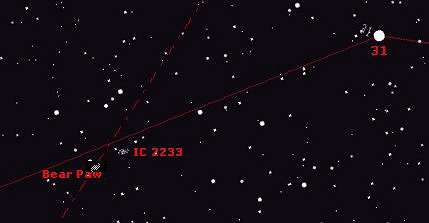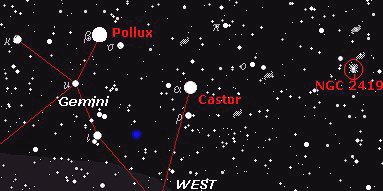Spring Flowers and Spiral Galaxies Part 1, A Look
at Lynx
By Karl Schmidt
 April brings spring
flowers and spiral galaxies. In the east, the spring constellations are
rising, and leading the way is Leo the Lion. To the northeast
is the Great Bear, Ursa Major, and in the southeast is the virgin
Virgo. In between these constellations lie the smaller, lesser
known constellations of Lynx, Leo Minor, Coma Berenices, and Canis Venatici.
Just as wild flowers spread throughout a field bring texture and wonder,
so do the galaxies within these constellations. This part of the
sky holds some of my favorite springtime galaxies and other interesting
objects.
April brings spring
flowers and spiral galaxies. In the east, the spring constellations are
rising, and leading the way is Leo the Lion. To the northeast
is the Great Bear, Ursa Major, and in the southeast is the virgin
Virgo. In between these constellations lie the smaller, lesser
known constellations of Lynx, Leo Minor, Coma Berenices, and Canis Venatici.
Just as wild flowers spread throughout a field bring texture and wonder,
so do the galaxies within these constellations. This part of the
sky holds some of my favorite springtime galaxies and other interesting
objects.
 Let me begin
in the northern part of Lynx near Alpha Lynxis a 3.1 mag star.
Less than one degree east of Alpha is NGC 2859, a magnitude 10.7
galaxy, round with bright core. It is medium size at 4 arcminutes. Less
than one degree south of Alpha lies a galaxy group called Abell 779.
The brightest member of this group is NGC 2832, 11.5 mag., considerably
large and extended in my 10 inch telescope. More challenging are
two round mag. 15.0 members of Abell 779, which are NGC 2827 (very
faint, very small), and NGC 2833 (faint, pretty small). Moving further,
about 6 degrees west of alpha is NGC 2683, a nice SA spiral galaxy
of mag 9.7. 2683 is very elongated, dusty, and has a bright core.
Let me begin
in the northern part of Lynx near Alpha Lynxis a 3.1 mag star.
Less than one degree east of Alpha is NGC 2859, a magnitude 10.7
galaxy, round with bright core. It is medium size at 4 arcminutes. Less
than one degree south of Alpha lies a galaxy group called Abell 779.
The brightest member of this group is NGC 2832, 11.5 mag., considerably
large and extended in my 10 inch telescope. More challenging are
two round mag. 15.0 members of Abell 779, which are NGC 2827 (very
faint, very small), and NGC 2833 (faint, pretty small). Moving further,
about 6 degrees west of alpha is NGC 2683, a nice SA spiral galaxy
of mag 9.7. 2683 is very elongated, dusty, and has a bright core.
 Now lets find 31
Lynx, a spectral K5III ( red ) star. Take a moment and enjoy
the richness of its hue that I find astonishing. Roughly three degrees
northwest is the Bear Paw Galaxy, NGC 2537, which has a brightness
of 11.7, and is a round dusty dwarf galaxy or possibly a globular cluster.
Just southeast of the Bear Paw is IC 2233, a challenging galaxy at magnitude
13. IC 2233 is edge-on however, making it easier to spot than if it were
face-on. It's size is a respectable 4.5 acrminutes.
Now lets find 31
Lynx, a spectral K5III ( red ) star. Take a moment and enjoy
the richness of its hue that I find astonishing. Roughly three degrees
northwest is the Bear Paw Galaxy, NGC 2537, which has a brightness
of 11.7, and is a round dusty dwarf galaxy or possibly a globular cluster.
Just southeast of the Bear Paw is IC 2233, a challenging galaxy at magnitude
13. IC 2233 is edge-on however, making it easier to spot than if it were
face-on. It's size is a respectable 4.5 acrminutes.
 Finally, another interesting
sight in Lynx is the Intergalactic Wanderer, NGC 2419, a fairly
bright, pretty large unresolved globular cluster, with a bright 7th magnitude
star just west of it. radually brighter middle, stars of magnitude 7 or
8 magnitude. Although this object is in Lynx, its easier to use the
bright stars Castor and Pollux in Gemini to locate it. Clear skies!!!
Finally, another interesting
sight in Lynx is the Intergalactic Wanderer, NGC 2419, a fairly
bright, pretty large unresolved globular cluster, with a bright 7th magnitude
star just west of it. radually brighter middle, stars of magnitude 7 or
8 magnitude. Although this object is in Lynx, its easier to use the
bright stars Castor and Pollux in Gemini to locate it. Clear skies!!!
Also check out other Spring constellations Ursa
Major and Leo.
And be sure to visit the Constellation
of the Month Archive.
 April brings spring
flowers and spiral galaxies. In the east, the spring constellations are
rising, and leading the way is Leo the Lion. To the northeast
is the Great Bear, Ursa Major, and in the southeast is the virgin
Virgo. In between these constellations lie the smaller, lesser
known constellations of Lynx, Leo Minor, Coma Berenices, and Canis Venatici.
Just as wild flowers spread throughout a field bring texture and wonder,
so do the galaxies within these constellations. This part of the
sky holds some of my favorite springtime galaxies and other interesting
objects.
April brings spring
flowers and spiral galaxies. In the east, the spring constellations are
rising, and leading the way is Leo the Lion. To the northeast
is the Great Bear, Ursa Major, and in the southeast is the virgin
Virgo. In between these constellations lie the smaller, lesser
known constellations of Lynx, Leo Minor, Coma Berenices, and Canis Venatici.
Just as wild flowers spread throughout a field bring texture and wonder,
so do the galaxies within these constellations. This part of the
sky holds some of my favorite springtime galaxies and other interesting
objects.
 Let me begin
in the northern part of Lynx near Alpha Lynxis a 3.1 mag star.
Less than one degree east of Alpha is NGC 2859, a magnitude 10.7
galaxy, round with bright core. It is medium size at 4 arcminutes. Less
than one degree south of Alpha lies a galaxy group called Abell 779.
The brightest member of this group is NGC 2832, 11.5 mag., considerably
large and extended in my 10 inch telescope. More challenging are
two round mag. 15.0 members of Abell 779, which are NGC 2827 (very
faint, very small), and NGC 2833 (faint, pretty small). Moving further,
about 6 degrees west of alpha is NGC 2683, a nice SA spiral galaxy
of mag 9.7. 2683 is very elongated, dusty, and has a bright core.
Let me begin
in the northern part of Lynx near Alpha Lynxis a 3.1 mag star.
Less than one degree east of Alpha is NGC 2859, a magnitude 10.7
galaxy, round with bright core. It is medium size at 4 arcminutes. Less
than one degree south of Alpha lies a galaxy group called Abell 779.
The brightest member of this group is NGC 2832, 11.5 mag., considerably
large and extended in my 10 inch telescope. More challenging are
two round mag. 15.0 members of Abell 779, which are NGC 2827 (very
faint, very small), and NGC 2833 (faint, pretty small). Moving further,
about 6 degrees west of alpha is NGC 2683, a nice SA spiral galaxy
of mag 9.7. 2683 is very elongated, dusty, and has a bright core.
 Now lets find 31
Lynx, a spectral K5III ( red ) star. Take a moment and enjoy
the richness of its hue that I find astonishing. Roughly three degrees
northwest is the Bear Paw Galaxy, NGC 2537, which has a brightness
of 11.7, and is a round dusty dwarf galaxy or possibly a globular cluster.
Just southeast of the Bear Paw is IC 2233, a challenging galaxy at magnitude
13. IC 2233 is edge-on however, making it easier to spot than if it were
face-on. It's size is a respectable 4.5 acrminutes.
Now lets find 31
Lynx, a spectral K5III ( red ) star. Take a moment and enjoy
the richness of its hue that I find astonishing. Roughly three degrees
northwest is the Bear Paw Galaxy, NGC 2537, which has a brightness
of 11.7, and is a round dusty dwarf galaxy or possibly a globular cluster.
Just southeast of the Bear Paw is IC 2233, a challenging galaxy at magnitude
13. IC 2233 is edge-on however, making it easier to spot than if it were
face-on. It's size is a respectable 4.5 acrminutes.
 Finally, another interesting
sight in Lynx is the Intergalactic Wanderer, NGC 2419, a fairly
bright, pretty large unresolved globular cluster, with a bright 7th magnitude
star just west of it. radually brighter middle, stars of magnitude 7 or
8 magnitude. Although this object is in Lynx, its easier to use the
bright stars Castor and Pollux in Gemini to locate it. Clear skies!!!
Finally, another interesting
sight in Lynx is the Intergalactic Wanderer, NGC 2419, a fairly
bright, pretty large unresolved globular cluster, with a bright 7th magnitude
star just west of it. radually brighter middle, stars of magnitude 7 or
8 magnitude. Although this object is in Lynx, its easier to use the
bright stars Castor and Pollux in Gemini to locate it. Clear skies!!!